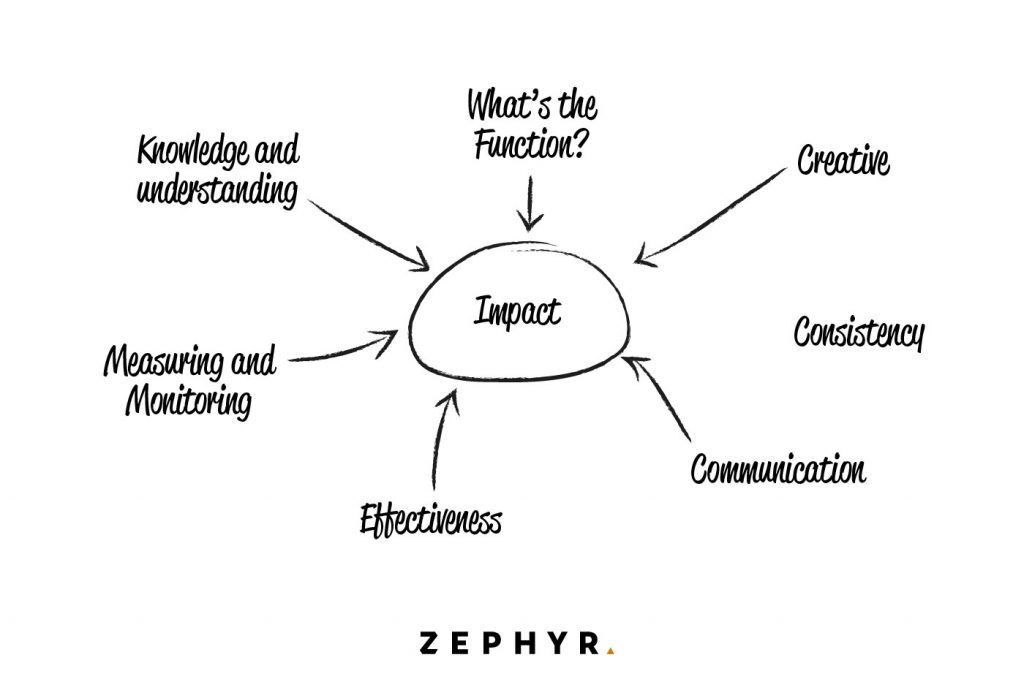At Zephyr, it’s our business to ask ourselves how we can deliver an impact, generate interest and ultimately new business for our clients.
My job, as Senior Designer, is to help make sure we understand our client’s businesses inside and out. It’s one of my favourite parts of the creative process because as we discover and learn about our clients we are also challenging ourselves to find a creative solution that really stands out.
I thought it might be useful to share a little insight as to how I approach this process, you never know, it may help inspire you to take a fresh look at how your business currently interacts and engages with your own audiences.

Knowledge and understanding
We like to know the journey our clients have been on and understand what has, and hasn’t, worked for them in both a marketing and business sense so we make it our priority to really get under our client’s skin and challenge how they think about their brand. Sometimes this involves a few awkward questions and challenging conversations but then it’s always a really positive journey and guaranteed to make a real difference. It’s standard stuff in terms of the creative design or marketing process really but it is key to help realise a direction and devise a plan moving forward.
Naturally, the audience is the vital part of any project because they will ultimately decide whether or not to contribute towards the impact and success of what you are trying to achieve and therefore will hold the answer to the problem. This always needs to specific to every business and surprisingly often gets overlooked or undervalued by business owners – perhaps it’s too easy to become complacent and assume our target market will always want our product or services. Sadly, that’s not the case.
Function
What is the goal? Who is the audience? How easy is it to use? These are some of the core questions we need to know and the answers need to drill down and be specific. This should even reach across every area of the business – how will improvements in a client’s brand and marketing approach affect the service or product development team, what impact will this have on the customer services team? Etc.
Creative
The way something looks can deliver extraordinary impact when executed in the correct way, however, there is often the temptation to ‘push the envelope’ and try some new and interesting. Sometimes this can result actually in overly complex solutions that only end up alienating the audience because they don’t understand the product or the messaging you are trying to convey. The key is to keep it simple, be different and be memorable – no pressure there then!
Consistency
As designers, we always talk about the importance of brand consistency, not because we like everything looking straight and perfectly aligned (we do!), but from an audience perspective, it’s all about recognising your brand and becoming familiar with your message. The general rule is that it takes 3 views to become engaged with a new brand so if you are not consistent in every big and small thing you do both offline and online, you are damaging your own chances of success.
Communication
The tone or language used is really important to delivering impact because once the creative has caught the audience’s attention the language then needs to be effective enough to convey what it is you are trying to say to that audience at that particular time in their day or lives.
Effectiveness
Sometimes selecting the right platform or media can have an impact on the message you are trying to communicate as well as reducing the amount of time you spend creating it. For instance, if you have a news item you want to communicate to your audience, which will deliver you the best impact and retention; a blog, a press release, a tweet or all?
Studies show that visual forms of communication such as images and video are twice as effective as reading and offers increased retention showing that a picture really is worth a thousand words.
Measuring and Monitoring
We always see design as an investment rather than an expense because done effectively, you should see an impact from your output each and every single time, whether it’s product or service sales or lead generation.
It’s always important to measure and monitor the impact your marketing is having as this can help to gain insights as well as learn what works and what does not. Ultimately there will be negatives but hopefully, they can be used to change your strategy to be more effective in future marketing output. Bad is not always bad, it can often be a fantastic opportunity!
The thing to remember is that delivering impact is more than just about a website, a logo or the way a brand looks, it’s a lengthy and continuous piece of work about creating a clear brand strategy that resonates with your audience. The strategy is not a fixed set of rules or guidelines, there will be good points and bad points but the key thing is that you learn from the bad and act accordingly.


Leave a Reply